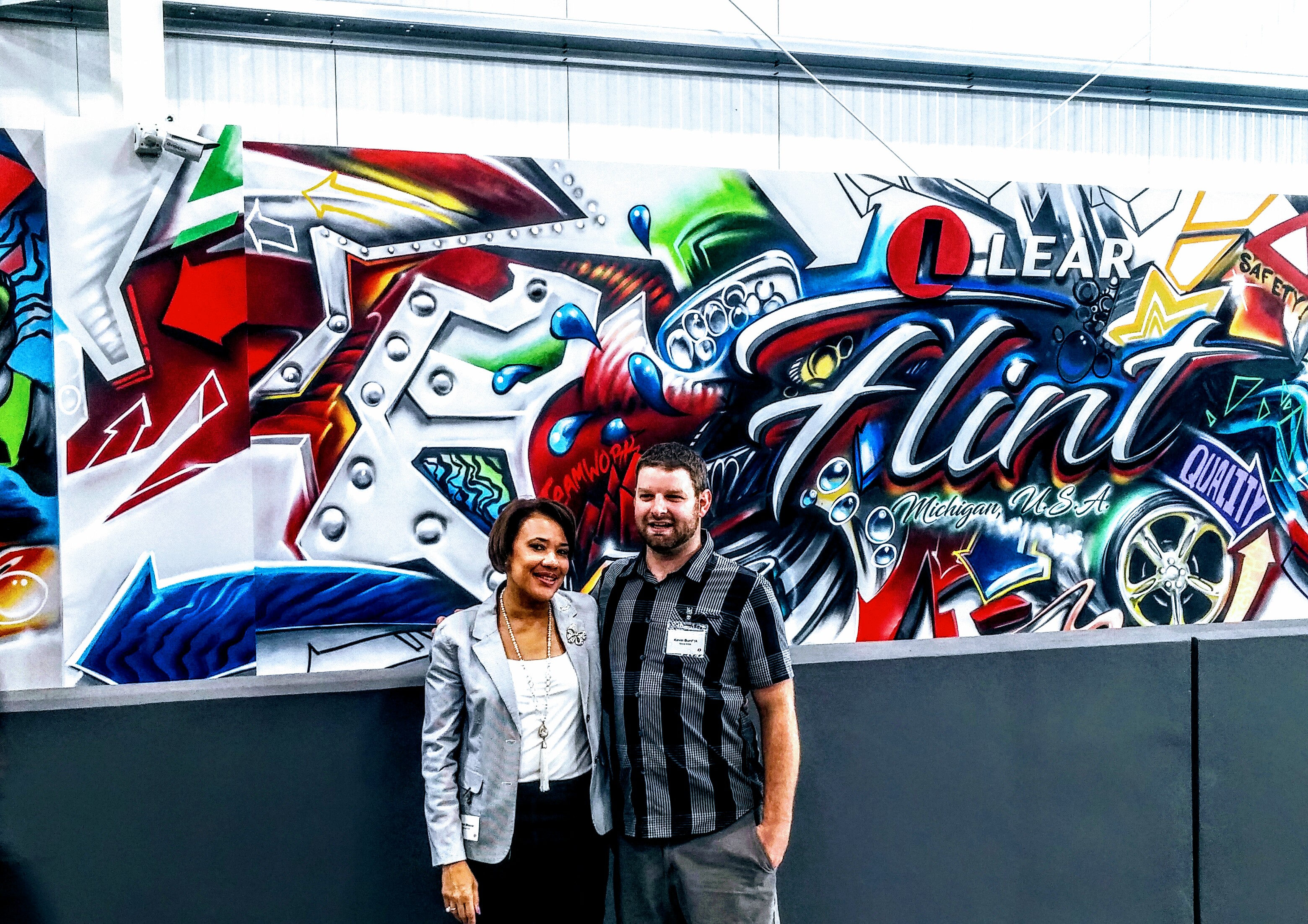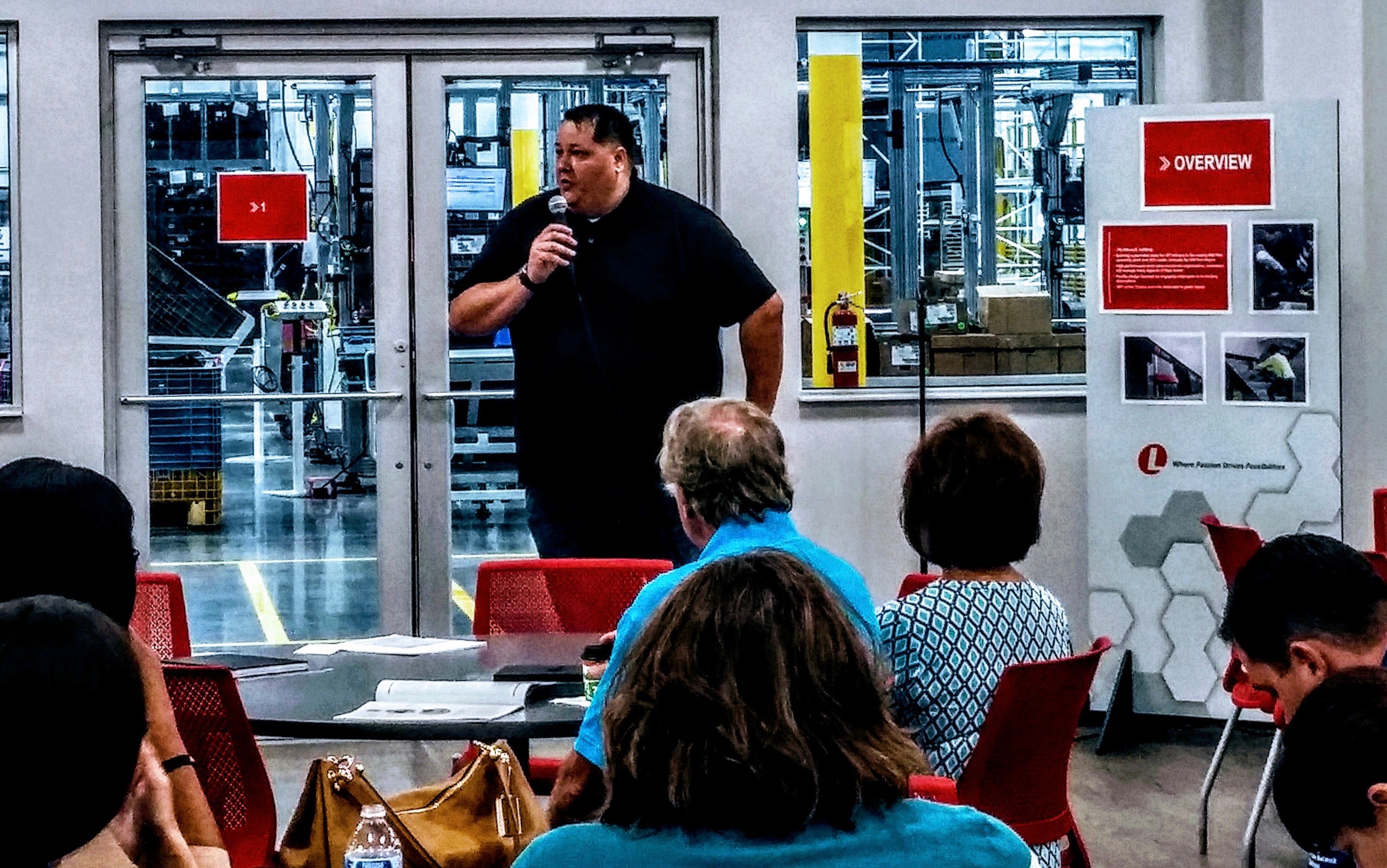By Jeffery L Carey Jr
A new Lear Flint Seating Plant, the first major automotive supplier manufacturing facility constructed in Flint in more than 30 years, opened Saturday, Aug. 11 on a formerly overgrown Buick City brownfield.
The project was funded with a $29.3 million capital investment by Lear and a $4.35-million Michigan Business Development Program grant.
Lear, a global corporation doing business in 39 countries, does subassembly and final assembly of automotive seats. The Flint facility has 156,000 square feet, with 30 percent of the more than 33-acre site set aside for green space. It opened with 100 production employees, most from the Flint area, with plans to increase to 600 and three shifts over the next few years.
While the factory occupies only about 15 percent of the acreage which was once home to the largest manufacturing complex in the world, the opening represented a positive step for the Buick City site, which had employed thousands in 24 separate buildings in its heyday, but had sat completely empty since 2010.
Lear representatives say they hope the new plant will be an inspiration for bringing manufacturing back to Flint.
“That’s not an easy task,” Plant Manager Tim Reedy said at the grand opening ceremony. “That’s taking it to world-class, you know.” He said he believes his team has the hunger and passion to do it.
While Reedy said he was unable to discuss production numbers due to proprietary concerns with their customers, he said the plant is currently running one shift with trucks shipping twice a day to the General Motors facility in Fort Wayne, Indiana.

Inside the new plant on the day of the grand opening (Photo by Darlene Carey)
About 60 local dignitaries, including Mayor Karen Weaver, were present for the opening, with tours and a barbecue for employees and their families continuing throughout the day.
According to Reedy, employees at the Lear Seating Plant are not unionized yet. “It’s in the hands of the employees. They’re going to be able to vote and that will happen sometime next year when we really start ramping up.” He said among other hires the initial 100 will be joined by 150 “legacy employees” transferring from the United Auto Workers.
Reedy, a former student at Mott Community College and Kettering University who came back to his hometown from another plant for the Flint position, noted many efforts to connect with the community, including Lear’s partnership with Mott Community College when hiring new employees.
“We did an on-boarding [the process of integrating a new employee into an organization] and that’s where they did all of the interviewing.” Reedy said.
“They spent about a week and a half between learning our core values as a corporation and ‘lean manufacturing’ [according to Wikipedia, a system for minimizing waste without sacrificing productivity] and then we spent two to three days out into the community with the on-boarding of community service just to show our commitment to the community.”
One example is that Lear is building a new park for the community located across the street from the plant.
Another example is Lear’s “safe driving and distracted driving initiative” to encourage people to stay off their phones while driving. “We’ve taken on a pledge to educate at least 100,000 people,” Vice President Jason Scott said as he urged people to ignore their texts while driving.

Flint muralist Kevin Burdick with Mayor Karen Weaver at the new Lear plant (Photo by Darlene Carey)
Lear hired local artist Kevin Burdick of Scraps Designs to paint a more than 40-foot-long mural inside the building. The mural, located in the production area was first sketched, Burdick said, then after plant approval, was painted using an airbrush in two weeks. Titled, Directional Innovation, the mural represents Flint’s history in the automotive industry and Lear’s commitment to quality and community.
A collaborative environment is clearly visible with the design of the building, its lack of segregation between management and hourly employees and their use of spaces such as the kitchen, break rooms, restrooms and open plan cubicles with work tables poised in the center of spacious aisles.
“It’s all Herman Miller, [a Michigan-based company],” stated Claudette “Coco” Kaado, Lear Flint Seating Plant’s facility designer. “They wanted innovation to be organically driven,” she said, adding the company wanted every space to be enjoyable. From the color scheme to the industrial design, employees collaboratively decided on the look of the building. All of the wood and construction materials were local to Flint, including the salvaged wood used on the lobby wall.

Plant Manager Tim Reedy addresses visitors at the Lear opening (Photo by Darlene Carey)
Employee training at Mott Community College included a focus on “outward mindset” and emotional intelligence. Lear’s goal, Reedy said, is to create a “cohesive mindset” where the employees don’t just feel like they are coming in and “punching a box.”
Employees are broken up into teams and committees to learn different skill sets in a cross training and inclusive atmosphere. This way, Reedy said, they would have upward mobility within the corporation.
GM participated in the Lear training as well, inviting Lear employees to tour a plant and watch a Chevy Silverado get built—to see where their seats are going.
“So that was pretty impressive,” Reedy said–to see the whole operation. “They were just excited to be a part of this and that’s how we build this to be our flagship.”
Lear expects to offer another job fair in early 2019. “We will broadcast that in the community,” said Jenny Gogan, Lear’s global marketing and communications manager. “We will also post jobs on our careers page on our website as they become available.”
Like Reedy, some of the Lear employees came from Eagle Ottawa, acquired by Lear five years ago, followed by a $10 million investment. The acquisition places the largest global supplier of automotive leather, with annual sales of approximately $1 billion, into the hands of the Lear Corporation.

Rich Reed (left) and Steve Branch of Flint, both of whom once worked for Buick, stand with the groundbreaking shovel for the new plant in front of a photo of the way Buick City used to look. (Photo by Darlene Carey).
Asked about Eagle Ottawa moving some of its operations to Mexico, Reedy stated Eagle Ottawa Leather Division is, “the tip of the spear and is still in Rochester Hills. It’s a large R&D facility.”
Lear is considered a “Tier One” automotive supplier as these are companies that offer the most advanced processes in the supply chain, the final step before the product reaches the Original Equipment Manufacturer or OEM.
Reedy said company officials hope to be running all three shifts within a year. He said they had worked closely with a “Tier Two” company in Howell, MI that did a lot of the fabrication, stamping and back framing.
“It’s all local,” he said, “and it’s been really good for us as we went into the launch phase they’re right in Howell and they can come right into the facility and work with us.”
Lear officials say they hope to begin working with GM Flint Assembly soon. With just a seven-minute drive to the facility, the plant is conveniently located for “just in time” supply. “It gives us a competitive advantage,” Reedy stated. “A strong suit of ours is our relationship with General Motors.”
Lear is a global company that often builds its facilities near its customers. Globally it is located in 39 countries with approximately 165,000 employees. The seat manufacturer supplies nearly all of the automotive manufacturers in the world.
Asked about the recent trade tariffs imposed by the Trump administration in January targeted at solar panels, washing machines, steel and aluminum, Reedy said he had not seen any effects on Lear’s business.
EVM Staff Writer Jeffery L. Carey, Jr. can be reached at jlcareyjr@hotmail.com.

Herman Miller furniture, including these gleaming lockers, are featured throughout the new plant (Photo by Darlene Carey).


You must be logged in to post a comment.